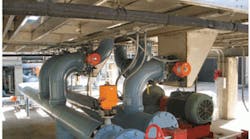At the University of North Florida (UNF) in Jacksonville, Fla., labor savings was the primary driver for a carefully orchestrated control strategy, one that gives chilled-water-plant personnel computerized remote control of chilled water and cooling-tower operation.
With more than 50 Belimo actuated control valves in the UNF chiller plant alone, facility personnel can mix and match chiller and cooling-tower operation seamlessly via an Andover Continuum building-management system (BMS) according to load or other requirements. For example, if a tower needs servicing or cleaning, the system will switch over to another cooling-tower cell automatically.
With actuated-valve control over five 1,000-ton chillers and 10 500-ton cooling towers, UNF is equipped with a lot of operational flexibility, all of which is completely automated through the actuated valves and BMS.
"We've tried to leverage automation to keep from buying labor, so I don't have to have a man out there physically turning a valve on or off," Wallace Harris, associate director of facilities for UNF, said. "It's much cheaper this way."
The system automatically makes the necessary changes should any of the hot- or chilled-water equipment go into fault. Harris and other facility staff receive e-mail and text notifications of any critical alarms from the Andover system, but there is no "babysitting" of equipment.
Automation Equals Optimization
There is a significant energy advantage to all of this automation. Most importantly, UNF is not pumping water through cooling towers when it does not need to. If return-water temperature is low, UNF can take one or more cooling towers off line without danger of overflowing a basin, which would lead to more unnecessary energy use. Both two-position and modulating valves are in place, so the plant can accurately vary flow through the cooling towers while maintaining set points and minimizing energy consumption.
The valves and actuators help UNF take advantage of a system that recovers the heat rejected from the cooling towers and uses it for hot-water reheat. This offsets some of the additional energy required to reheat the chilled water after it has been overcooled for dehumidification purposes.
"There are multiple valves that dictate which cooling tower gets linked to the heat-recovery package," Dave Sarratori, construction manager with Facility Automation Solutions, said. "The control system automatically adjusts so that the cooling tower with the greatest load is the one that feeds the heat-recovery system. This is particularly useful since the chilled-water system is required for year-round dehumidification."
Approximately 2.2 million sq ft of UNF building space is fed off of the central chilled-water system. The system is all-variable-flow, so Belimo pressure-independent valves are utilized throughout the campus to regulate flow through air handlers, variable-air-volume boxes, and other terminal units automatically, regardless of changes in load or pressure. These automatic adjustments eliminate a lot of balancing labor and help UNF save pump energy.
Information and photograph courtesy of Belimo.
For Design Solutions author guidelines, call Scott Arnold, executive editor, at 216-931-9980, or write to him at [email protected].









